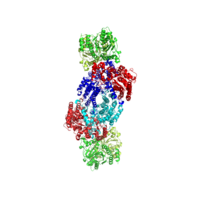
Photo from wikipedia
Abstract Despite having a wide range of applications as an organic–inorganic hybrid perovskite, detailed studies of the physical properties and structural dynamics of [NH3(CH2)4NH3]ZnBr4 crystals have not been published to… Click to show full abstract
Abstract Despite having a wide range of applications as an organic–inorganic hybrid perovskite, detailed studies of the physical properties and structural dynamics of [NH3(CH2)4NH3]ZnBr4 crystals have not been published to date. This work investigates the structural properties of these crystals using X-ray diffraction, differential scanning calorimetry (DSC), and thermogravimetric analysis (TGA). The crystal structure was orthorhombic, and the phase-transition temperatures were 354, 434, and 514 K. In addition, the physicochemical properties of the cations in this crystal were investigated using 1H and 13C nuclear magnetic resonance (NMR) relaxation. The structural environments of 1H and 13C as evaluated by chemical shifts in the [NH3(CH2)4(NH3)] cation did not change significantly with increasing temperature. The spin-lattice relaxation times T1ρ for 1H were dependent on temperature change, but the T1ρ for 13C located in the center of the N–C–C–C–C–N bond was nearly independent of temperature. We compared [NH3(CH2)3NH3]ZnBr4 crystals previously reported and the [NH3(CH2)4(NH3)]ZnBr4 crystals prepared herein.
Journal Title: Journal of Solid State Chemistry
Year Published: 2021
Link to full text (if available)
Share on Social Media: Sign Up to like & get
recommendations!